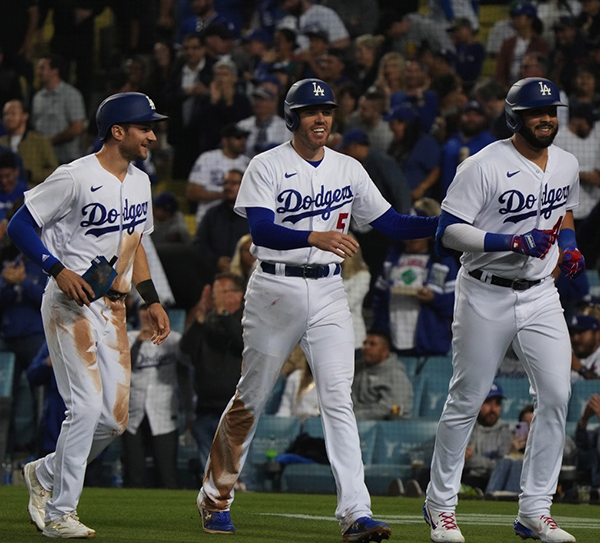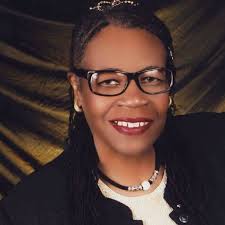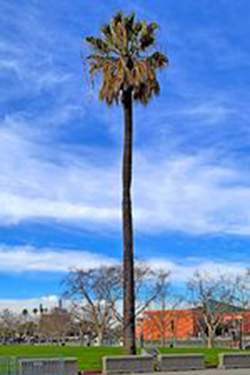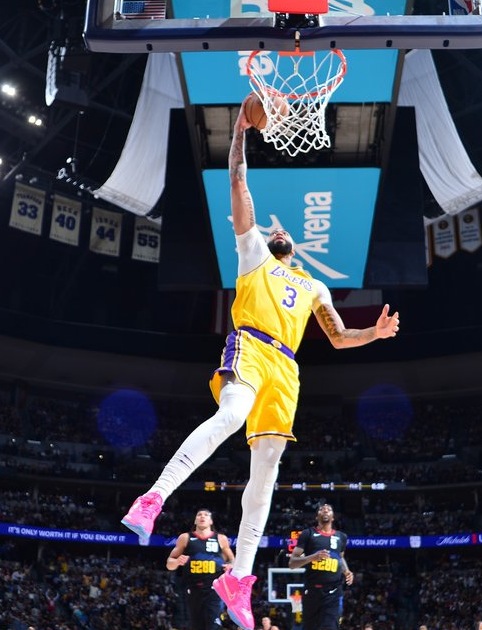By Don Wanlass
Contributing Writer
The Dodgers have had their first lull of the season and they still have the second best record in all of baseball (only the Yankees are better) and the best record (24-12) in the National League.
Three of their top hitters aren’t hitting, two of their starting pitchers and one of their best relievers are on the injured list and the Dodgers are where they figure to be all season: leading the National league West on their way to the playoffs for the 10th straight time.
After losing five of seven to the Pittsburgh Pirates and Philadelphia Phillies (the first time all year they have lost back-to-back series), the Dodgers got well in a hurry this week against the Arizona Diamondbacks, extending a winning streak to four games by sweeping a doubleheader May 17, coming from behind to win 7-6 in the first game and then scoring eight runs in the second inning of the second game on the way to a 12-3 win.
Two standouts from that second game sum up why the Dodgers have been in the playoffs for nine straight seasons: the front office keeps finding (and developing) new talent.
Tyler Anderson made his fifth start of the season for the Dodgers. After giving up two home runs in the first inning, he settled down and surrendered only five hits over the next six innings in notching his fourth win against no losses so far this season.
Anderson was signed in the offseason to provide depth for the Dodgers pitching staff. In six major league seasons prior to this year, he had a 33-38 record and an earned run average of about 4.5.
At the start of the season, he was pitching behind Tony Gonsolin, Gonsolin would start and Anderson would follow him out of the bullpen.
Then Andrew Heaney hurt his shoulder and Anderson was thrust into the starting rotation. It will be hard to remove him, if and when Heaney gets healthy.
In 35-plus innings, Anderson has 34 strikeouts and only five walks. His one bad outing came against the Phillies last week when he gave up seven runs in six innings.
Other than that, he has given up nine runs in 30 innings, a 2.70 ERA.
It seems like every year the Dodgers find someone who surprises everyone and Anderson could be that player this year.
Capping the eight-run second inning for the Dodgers May 17 was Edwin Rios, who hit a three run home run to the opposite field that barely cleared the fence in left-center field.
Rios is someone the Dodgers need to get into the lineup more often. While the Dodgers were losing two out of three to the Pirates last week, Rios was 5-for-10 during the series with two home runs and seven runs batted in.
After going 0-for-3 in the first game of the Phillies series, manager Dave Roberts sat Rios until putting him back into the lineup for the second game of the doubleheader as the designated hitter. His home run was his fourth of the season in only 42 at bats.
Rios showed glimpses of potential in the COVID-shortened 2020 season when he hit eight home runs in 76 at bats, but he was hitting .078 when he underwent season-ending shoulder surgery in May 2021.
He’s healthy again this year and Roberts needs to get him into the lineup more often, especially against right-handed pitching.
Justin Turner, Mac Muncy and Cody Bellinger still aren’t hitting consistently, but the top three hitters in the Dodgers lineup — Mookie Betts, Freddie Freeman and Trea Turner — are shouldering the load and that’s why the Dodgers keep winning.
Injuries to Heaney and Clayton Kershaw have forced the Dodgers to force feed young starters Ryan Pepiot and Michael Grove into the rotation, but help is on the horizon as Dustin May starts to ramp up his throwing program on the way back from Tommy John surgery.
He should be back in August, an addition to the starting rotation that will be better than just about any trade acquisition.
The Dodgers may lose four games in a row again this season. They might have another lull when they lose five of seven again.
But the Dodgers are built for the long haul and when October comes expect them to be favored to win another World Series.
WINNING BACK THE FANS: The Los Angeles Sparks don’t get mentioned often here, but their season is underway and May 17 marked the home opener at Crypto.com Arena.
The Sparks gave up a last-second layup and lost to the previously winless Minnesota Lynx, dropping their record to 2-3.
The Sparks drew more than 4,700 fans to the game, the first played in their home arena since 2019 without COVID restrictions.
Prior to COVID, the Sparks led the WNBA in attendance for three straight years. They are seeking to regain the home-court advantage a large crowd brings while breaking in a new roster.
Only three players who played significant minutes last year are still on the roster and one of those — Kristi Tolliver — is currently preoccupied helping coach the Dallas Mavericks in the NBA playoffs.
The Sparks acquired local product Jordin Canada (Windward High and UCLA), 6-8 Liz Cambage and Katie Samuelson in the offseason and got off to a 2-0 start before losing their last three games.
Nneka Ogwumike is leading the team in points and rebounds (16.6 and 8.2, respectively) through the first five games and Cambage and Canada are each scoring at least 14 points a game.
Head coach and general manager Derek Fisher (yes, that Derek Fisher) has a new boss to please after the Sparks named Vanessa Shay as the new team president this week.
Shay is promising to increase the brand awareness of the Sparks, a hard nut to crack in a market like Los Angeles. Winning is everything here and the Sparks last won a WNBA title in 2016.
After going two seasons where they hardly played in front of their own fans (last year they played 11 of 16 home games at the Los Angeles Convention Center), the Sparks hope the new additions this year can bring them back to contention in the WNBA, which is still trying to grow out of its niche sport role in the sporting hierarchy in Los Angeles.
DEATH OF A LEGEND: There are lots of legendary basketball players who grew up playing on the courts of Los Angeles, especially South Los Angeles. One of those legends died last month.
Freeman Williams died April 19 at the age of 65. Only a diehard NBA fan would know the name because Williams, at 6-4, 190 pounds, was a three-point shooter before three-point shooting was considered the valuable asset it is in the NBA today.
Williams attended Manual Arts High School, graduating in 1974. But it was at Portland State, where Williams made his name.
He led the NCAA in scoring during the 1977 and 1978 seasons, averaging 39 points a game as a junior and 36 points a game as a senior. Finishing behind Williams in 1978 was some guy from Indiana State named Larry Bird.
Williams is the second leading all-time scorer in NCAA Division 1 history, trailing only Pete Maravich with 3,249 points.
He scored 81 points against Rocky Mountain College in February 1978 and scored more than 60 points in a game two other times. More than 40 years later, he is still Portland State’s leading career scorer.
He was a first-round draft pick of the Boston Celtics in 1978, but was traded by the Celtics to the then-San Diego Clippers before the 1978 season started.
He played three and half seasons with the Clippers before getting traded to the Atlanta Hawks during the 1981-82 season. He played only 27 more games in the NBA after that season. During his career, he averaged 14.7 points a game, mostly as a player who came off the bench to provide instant offense.
At the end of his career, he was traded for Hall of Famer Dominique Wilkins.
Wilkins was drafted by the Utah Jazz in 1982, but refused to sign with the Jazz. Freeman was included in the trade that sent Wilkins to the Hawks, where he blossomed into a star.
Williams played 18 games with the Jazz before being waived in December 1982. He played briefly for Washington in the 1985-86 season before playing in the Philippines in 1987, where he once scored 82 points in a game.
He had a small part in the 1992 film “White Men Can’t Jump, playing fictional playground legend Duck Johnson.
Like many former players, Williams struggled in his life after basketball, including a bout with drug addiction. After he got cleaned up, he was an assistant coach at Manual Arts under Dwayne Polee, another former Manual Arts star, for two years.
In 2012, he was featured in a documentary, “Inner City Champions,” with Polee about their journeys as prep basketball icons who struggled in their post-basketball lives.
In 2014, ESPN ranked him as the fourth best “playground legend” in California history.
That’s impressive when you consider all the basketball talent that California has produced over the years.
He is another example of a local athlete whose flame burned intensely for a short time before it was extinguished.
He surely deserves a mention whenever the playground greats of South Los Angeles are discussed.












